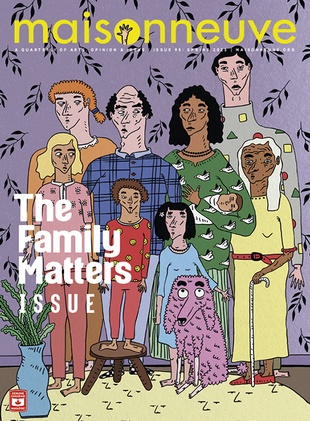Kitsch and Kalashnikov
The craft of Afghan war rugs

The inclination to weave story is age-old. Greek myth tells of Arachne, who dared to weave the errors of the gods into a tapestry and was turned into a spider by a jealous Athena. Helen wove the Trojan War as it raged in front of her. More recently, the Bayeux tapestries recounted the Norman conquest of England. Stories in cloth give voice to tragedy, to loss and to the decadence of society. They also give weavers an opportunity to depict the horrors of war.
War imagery in tribal Afghan carpets began appearing around 1980, shortly after the Soviet Union’s invasion of Afghanistan. Early pictorial, or aksi, war carpets are a fascinating hybrid of traditional abstract motifs slowly transforming into military objects. Where one might expect to find a boteh symbol (an ancient precursor to our paisley), one finds instead a woman in a burka beside a tiny Kalashnikov rifle—or a view from the ground of a B-52 unloading its deadly cargo. Such images meld into the overall formality of traditional patterns, however, so it is all the more shocking to find a Hummer or a fragmentation grenade on what is, at first glance, an exotic, nostalgic rug.
Hand-knotted carpets are Afghanistan’s third most important export item, after opium and food (nuts and fruit). Traditionally, women and children did all the weaving in tribal Afghanistan, though after twenty years of war and a broken economy, men have begun weaving as well. The ability to make carpets is customarily considered part of a woman’s dowry, as it means that she will be a money earner. Weavers are valued by their community, and the stories woven into the carpets link tribal generations verbally and visually. Some hypothesize that a taste for these carpets among Russian soldiers created a financial impetus for local craftswomen to alter and modernize their designs, but the argument is unpersuasive. A traditionally patterned rug, then as now, fetches two or more times the price for the same amount of work. A knot is a knot: even a small mat takes almost a month of constant toil.
The histories recounted in recent war aksi are profoundly disturbing. Some seem to employ images directly copied from propaganda leaflets that the US dropped on Afghanistan after 9/11: exploding twin towers, fighter jets taking off, and doves carrying olive branches between the Stars and Stripes and the current Afghan flag. Scholars and dealers have suggested that the carpets are a way for the weavers to express their stories and so come to terms with the trauma that is unfolding around them. Children learning to knot on these aksi will someday become adult weavers. Once the dust settles, one wonders what new stories may come flying from the hands of these young Afghan weavers. Will they continue to knot only guns and falling bombs? Will the age-old designs—and the millennia of collective history they represent—be among the collateral damage?
1(PREVIOUS PAGE)
PRIVATE COLLECTION. WOOL ON COTTON. This rug depicts an attempt to capture Osama bin Laden during the battle of Tora Bora. American intelligence was tracking bin Laden by way of his satellite cell phone, but, as the military closed in on its target, bin Laden pulled a Get Smart manoeuvre: he handed his phone to his Moroccan bodyguard, Abdallah Tabarak, and then walked away. Tabarak is now in custody at Guantánamo Bay, Cuba. Note the “MADE IN AFGHANISTAN SHBRGHAN.” Sheberghan is the location of a prison in the north of Afghanistan to which hundreds of rebel fighters were transported after the surrender of Kunduz in 2001. Many of the prisoners suffocated in transit, and there are allegations that others were executed upon arrival. Sheberghan is the third largest prison for Taliban and al-Qaeda insurgents, after Guantánamo Bay in Cuba and the Bagram air base in Kabul.
2 (DETAIL)
PRIVATE COLLECTION. WOOL ON WOOL. This is an early carpet, likely made between 1979 and 1989, during the Soviet Union’s occupation of Afghanistan. The weaver has mostly remained true to traditional expectations, but the military iconography is in the process of transforming traditional motifs: the camels are sprouting helicopter propellers, the wheat sheaves are becoming ballistas. These whimsical early carpets evoke a certain melancholy shock—the trauma of nostalgia giving
way to horrifying reality.


3 (DETAIL)
COLLECTION OF ALEJANDRO GODOY. WOOL ON COTTON.
PURCHASED IN NWFP DUBARRA REFUGEE CAMP IN PAKISTAN, IN 1989. The runner was made by Kyrgyz tribeswomen and children, on looms that half-filled their tents (the other half was living area). Tribal rugs made by nomads or semi-nomads are generally smaller and narrower than rugs made in a village or city, due to the impermanence of the weavers’ situations and the constrained physical space in which the rug can be knotted. This carpet follows a static pattern in an inventory of military tools, fooling the eye with its traditional formality.

4
COLLECTION OF HERAT CARPETS, TORONTO. WOOL ON COTTON. PROVENANCE: HERAT REGION, AFGHANISTAN, C. 1990, SHOWING IRANIAN INFLUENCE. In some carpets the traditional repeating flower or geometric border has been replaced with a line of fragmentation grenades or ammunition cartridges. Notice how the grenade in the upper left corner is transforming the boteh (or paisley) design. The poppies on this carpet are fascinating in that they represent not the blood of fallen soldiers we associate with World War One and Flanders fields, but the source of a decent wage for many destitute farmers who cultivate poppies for opium. Afghanistan produced 3,600 tons of opium in 2003. Sales of the drug helped fund the mujahedeen insurrection against the Soviet Union; opium may also have narcotically quelled the frustrated Soviet troops. 
5 (DETAIL)
PRIVATE COLLECTION. WOOL ON COTTON. Anti-aircraft machinery was frequently stolen from the Soviet army and then used against the invaders. Why the USSR brought in these vehicles is debatable since Afghanistan had no air force. Particularly interesting are the scattered poppies. Opium is the number one export from Afghanistan, accounting for two-thirds of the world’s illicit supply. Hand-woven carpets are the country’s number three export. This weaver managed to export both.






